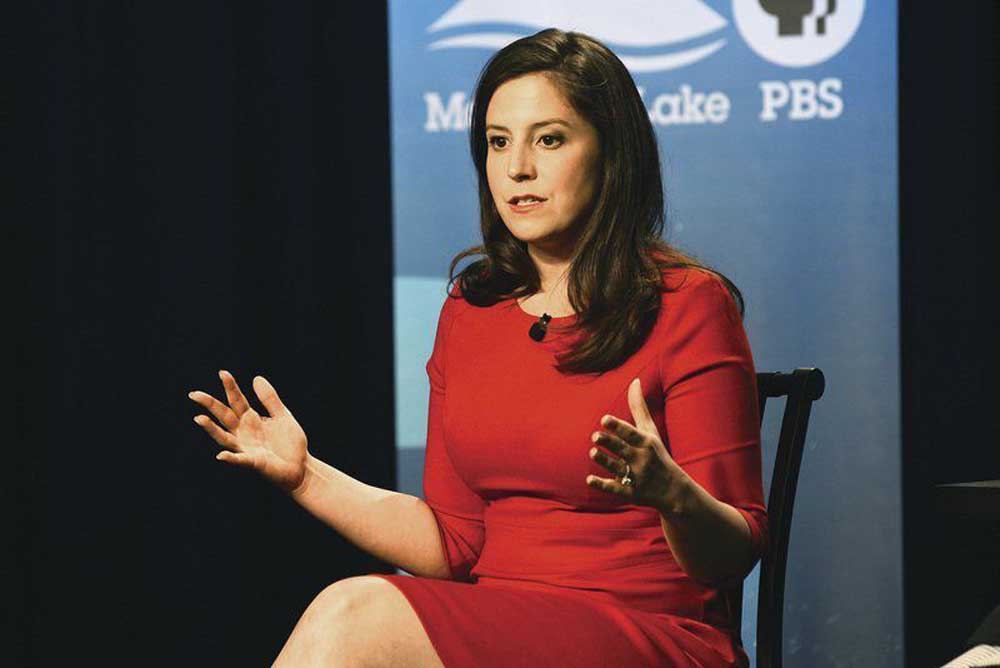Stefanik ready to ‘unite’ GOP in the House
Published 12:00 pm Tuesday, May 11, 2021

- (KAYLA BREEN/Plattsburgh, N.Y., Press-Republican) Rep. Elise Stefanik,R-N.Y., answers questions from a studio audience during a May 2017 community forum at Mountain Lake PBS in Plattsburgh.
PLATTSBURGH, N.Y. — If her congressional colleagues elevate her to a leadership post in the House GOP conference, Rep. Elise Stefanik, R-New York, says she will forgo a gubernatorial run and instead stay focused on helping her party regain control of the House of Representatives in 2022.
“I have been encouraged to run for conference many times before and took a pass,” she said in a recent interview. “This is a unique moment, though, where we need someone who can unite the entire Republican conference, and that’s what I’m running to do.”
Trending
House Republicans are slated to gather Wednesday morning to decide on whether Stefanik, backed by House Minority Leader Kevin McCarthy, R-Calif., should succeed Rep. Liz Cheney of Wyoming as GOP conference chair.
Cheney has broken ranks with the party’s leadership by remaining critical of former President Donald Trump as well as many Republican claims that the November election was stolen.
Stefanik, 36, was among the Republicans who voted against accepting the results of the Electoral College following the Jan. 6 attack on the U.S. Capitol. She opposed efforts to impeach Trump after he left office over accusations that he incited the insurrection.
In an interview, Stefanik revealed that she is now setting her sights on remaining conference leader only through the term that runs through 2022 and is not hemming herself in beyond that.
Ultimately, she said, she expects to be open to becoming a chairwoman of the House Education and Labor Committee or eventually the House Armed Services Committee.
“When you run for these leadership positions, I’m a big believer that you should run for the term you’re in, not for perpetuity, not beyond,” she said. “So I’m running for the term that would finish in the 2022 midterms, and my focus is on winning back the majority” for the GOP in the House of Representatives.
Trending
Endorsements have piled up for Stefanik to take over as GOP conference chair — the minority party’s third-highest position in the House.
Trump himself backed her last week.
“The House GOP has a massive opportunity to upgrade this week from warmonger Liz Cheney to gifted communicator Elise Stefanik,” the former president said in a statement issued through his Save America PAC. “She knows how to win, which is what we need!”
HARVARD TO D.C.
Stefanik’s transformation from moderate conservative to unabashed Trump supporter has been stark and a move that she says reflects the moods of her vast district in northernmost New York.
A native of Albany, Stefanik arrived in the 21st District — geographically the state’s largest, encompassing all of 10 counties and parts of two more — by way of Washington, D.C.
After graduating from the Albany Academy for Girls, a private prep school, she attended Harvard University, where she earned a degree in government. She then went to the nation’s capital to join the Bush administration, working as a staffer for the Domestic Policy Council and in the Office of the Chief of Staff.
She later worked for Tim Pawlenty’s presidential exploratory committee and two conservative think tanks, the Foundation for Defense of Democracies and the Foreign Policy Initiative. In 2012, she managed then-vice presidential candidate Paul Ryan’s debate preparation.
With the Republican ticket’s defeat that year, Stefanik returned home to work for the family’ business, Premium Plywood Products.
A year later, claiming roots in Willsboro, a small town on Lake Champlain where her parents own a seasonal home, Stefanik declared her candidacy for NY-21.
Recalling when she first emerged as a candidate, Ray Scollin of Saranac Lake, who sits on the New York Republican State Committee and formerly chaired the Franklin County GOP, described her as a fresh new face equipped with enthusiasm and a good grasp of politics.
“She seemed to have a solid direction of where she wanted to focus her energy, and I felt that was very refreshing,” he said.
In the 2014 Republican primary, Stefanik soundly defeated Matt Doheny, who had run unsuccessfully against incumbent Bill Owens, a Democrat, twice before.
Owens said he was surprised at the time by Stefanik’s obvious support from Republicans in D.C. “That was the first time I understood the depth of her connections to the Republican institution,” he said.
MODERATE AT FIRST
Stefanik, then 30, cruised to victory in the general election to become the youngest woman elected to Congress at the time.
Presenting herself as a moderate, she followed a path that others had blazed in the district, Owens said. She appeared to maintain that identity throughout her first term, as well as during Trump’s candidacy.
In 2016, she backed Ohio Gov. John Kasich in the GOP primary, only changing to support Trump when he emerged as the Republican presidential hopeful.
Though she viewed his popular proposal for a southern border wall as impractical, and disagreed with his denigrating statements about women and attacks on military families, Stefanik said he was the only candidate willing to work with a Republican Congress.
Noteworthy breaks with his agenda that followed included her vote against the 2017 tax overhaul bill. In fact, the political news website FiveThirtyEight gives Stefanik a career “Trump score” — how often she voted in line with the president — of 77.7% compared to Cheney’s 92.9%.
In 2018, however, Stefanik began to adopt Trump’s style, coining a nickname for her Democratic opponent, former St. Lawrence County legislator Tedra Cobb, whom Stefanik called “Taxin’ Tedra.”
It was during the 2019 impeachment proceedings against Trump, accused by Democrats of illegally withholding aid from Ukraine in exchange for investigations into the Bidens, that Stefanik gained a national profile as a member of the House Intelligence Committee and a staunch defender of the president.
“A new Republican Star is born,” Trump tweeted in November 2019 in the wake of Stefanik’s questioning of former U.S. Ambassador to Ukraine Marie Yovanovitch during an impeachment hearing.
Stefanik’s allegiance grew stronger after Trump’s acquittal. She consistently defended his response to the COVID-19 pandemic and was named co-chair of his re-election campaign in New York. She spoke at the 2020 Republican National Convention, an event she’d skipped four years prior.
After Trump lost the election, Stefanik supported his objections to the results. Though she did not explicitly say it was stolen, she peddled since-debunked claims about the vote, such as how there were more than 140,000 unauthorized ballots cast in Georgia.
In December, she signed onto a brief in favor of a lawsuit brought by Texas Attorney General Ken Paxton seeking to throw out election results in Georgia, Pennsylvania, Michigan and Wisconsin. The U.S. Supreme Court ultimately denied the case for lack of standing.
Ahead of the planned certification of Biden’s Electoral College win by Congress on Jan. 6, Stefanik announced plans to object to electors from those states. Ultimately, only her vote to object to Pennsylvania went through, as Republican senators who’d planned to raise objections to the other three states backed down in the wake of the storming of the Capitol.
‘RUN TO DAYLIGHT’
Owens equated Stefanik’s outlook with legendary football coach Vince Lombardi’s philosophy, “run to daylight.”
“That’s what Stefanik does,” he said. “I don’t think she has much in the way of core values. I think a door opens and she evaluates it, and if it looks good, she runs through. And I think she’s very smart, and I think she really works at understanding what’s going on, particularly in the Republican Party.”
But longtime allies tell a different story, describing Stefanik as an authentic voice.
Clinton County Legislature Chair Mark Henry, a Republican, pointed both to the instances when Stefanik came out against the Trump administration as well as her bipartisanship ranking.
Metrics followed by The Lugar Center, which account bill sponsorships and co-sponsorships, show Stefanik has shifted from 31st to the 13th most bipartisan member of the House from 2015 to the beginning of this year.
Henry calls her a “strong voice for the North Country.”
In the interview, Stefanik offered no apologies for evolving from a moderate when first elected to staking out much more conservative positions when Trump took the White House and her congressional district, with 53% of the vote, in 2016.
She said it is not uncommon for her to be “attacked as too conservative or attacked as not conservative enough.”
“My record has become more conservative over time, just as my district has trended from a double-digit (former President Barack) Obama district to a double-digit Trump district,” she said. “It was one of the swingiest districts in the country.
“If you look at that shift from Obama to Trump, the electorate in my district tells the story of the Republican Party and the inroads we’ve made to the working class, to traditionally blue collar Democrats who feel left behind by the far-left party.”
Stefanik said the Republican Party is poised to make gains both in New York and nationally, as the state Democratic Party and the Biden administration alienate blue-collar Democrats.
She dismissed criticisms from some newspaper editorial boards and liberal analysts on cable news networks as “nothing new.”
“‘I am the Democrats’ worst nightmare in that I am young, I’m a female, and that I am a female from the state of New York,” she said. “In (Democratic House Speaker) Nancy Pelosi’s warped world, I shouldn’t exist. But, in reality, I do.”
TRUMP’S MESSAGE
Stefanik said she believes she’s played an important role in helping Republicans “get this close to the majority” in the House; Democrats have 219 seats to the GOP’s 212, with four seats vacant.
Indeed, candidates endorsed by Stefanik’s E-PAC, launched after the 2018 mid-term elections with the aim of electing more Republican women to Congress, constituted more than half of the seats the GOP flipped in 2020.
Asked how she would deal with issues that could cause her to make a choice between following the GOP leadership or voting in the best interests of her district, Stefanik said Biden’s and Pelosi’s policies “are no in the best interest of my district, on any issue.”
Commenting on why she believes Trump’s message has appealed to voters in New York’s 21st District, Stefanik said the former president “spoke in very new ways to people who felt left behind.
“He spoke to the working men and women who were frustrated with unfair trade deals, who were frustrated with jobs being exported around the world, and the need to focus on manufacturing jobs right here at home,” she said.
She described the district as conservative on constitutional issues, like the Second Amendment and freedom of speech, which she said are under attack by the Democratic Party.
Among the top issues facing the country, she named the surge of migrants at the southern border, which has led to many border agents in northern New York being reassigned to patrol the border with Mexico.
She also said Republicans will push for reforms aimed at improving election integrity and what she called the “disastrous absentee ballot counting process” while supporting anti-crime measures at a time when some progressives are backing calls to reduce funding for police.
Economic issues are another major concern. Stefanik said Biden’s policies threaten to ratchet up inflation, increase taxes and do little to create jobs.
“We are going to expose how radical and how socialist the Democrats’ policies are,” she said.
Cara Chapman writes for the Plattsburgh Press-Republican. Joe Mahoney covers the New York statehouse for CNHI’s newspapers.






